#Homer defined
Text

#the simpsons#Monty burns#Montgomery burns#Charles Montgomery burns#My own personal thumbs up#Homer defined#S03e05#Gif
108 notes
·
View notes
Text
having a blorbo in greek mythology and epics is like the ancient world version of realizing the tv show had a different writer for the one episode your critter was wildly out of character and everyone is like "oh that's so them!" ??? did we watch the same show? helen of troy/sparta is a slut no wait she is a perfect woman no no she is a flawed human being no hold on she's a woman making her way in a man's world wait no she is the archetypal victim no wait-
not coincidentally i am reading madeline miller's the song of achilles for the first time and odysseus just showed up halfway through and odysseus'ed across the page so hard he made me fall in love with him all over again. achilles/patroclus is some foundational tragic queer romance, yeah i respect that, but odysseus. the laughing snake that tricks you into forgetting he is always ready to bite. my man
i bet he is a tricky character to write well but as long as he falls somewhere on the wile e. coyote <--> bugs bunny spectrum he is probably in character. because his character is to be tricksily varied. is he just a dude trying to get home? is he a larger than life hero? a rat bastard nobody can trust? the one male in hellas with a working brain who doesn't listen only to his dick or his overinflated ego? a wifeguy (positive)? a wifeguy (negative)? athena's special boy in this generation (telemachus and orestes wiping their noses on their blankets still)? or her latest mortal hackeysack, legs blurring in a looney tunes run between zany schemes, just a bit faster than the other doomed shmucks? all are intensely valid interpretations and go all the way back to homer 2800 years ago. incredible.
someone in the book is making fun of odysseus for bragging about how much he likes the ship, fresh from ithaca!! penelope modeled for the figurehead!!! he gets to see her while they're apart!!!! and that's why i set the book down for a minute. hgn. hdmahflshsk. odysseus sweetie pie i hope you still like it twenty years from now. the ghosts of my middle school english notes defining "dramatic irony" scream in ecstasy from the great beyond
#odysseus#the odyssey#the iliad#the song of achilles#madline miller#athena#helen of troy#helen of sparta#greek myths#greek gods#greek mythology#tagamemnon#do people still use tagamemnon?#orestes#telemachus#penelope of ithaca#dramatic irony#homer (the bard)#achilles#patroclus
219 notes
·
View notes
Text
"His eyes were always / tearful; he wept sweet life away, in longing / to go back home, since she no longer pleased him. / He had no choice. He spent his nights with her / inside her hollow cave, not wanting her / though she still wanted him."
Some have sensed a poignant sorrow in these lines. Gregory Hays, in his New York Times review of Wilson’s translation, says that “we feel sadness on both sides” here. But I have difficulty mustering the same sympathy for Calypso as for Odysseus, who must sleep with the goddess without desire and without choice. My students, ready to condemn Odysseus for his faithless philandering, are always caught off guard by this passage. Put simply, Odysseus — like all victims of rape — does not have the power to say no. His daily weeping recalls that of his wife Penelope, who spends tearful days within the women’s quarters of her palace. If gender is defined not as biologically determined but as a culturally constructed phenomenon informed by power, then it is not Calypso but Odysseus who plays the woman’s part in this episode.
114 notes
·
View notes
Text

!!This comment only serves as an example. I read similar statements on a daily basis!!
The Iliad, as a complex literary work, does not explicitly define the nature of Achilles and Patroclus's relationship in precise terms. While their bond is portrayed as exceptionally strong, the text leaves room for interpretation. Consequently, scholars and readers have different viewpoints on the nature of their relationship, ranging from friendship to romantic love. Engaging in definitive statements about their sexuality overlooks the inherent ambiguity and richness of the text, reducing it to a simplified binary discussion.
Moreover, what many people seem to forget is that the Iliad is not a historical account. As of now, we cannot determine if the Trojan War happened. The information we have suggests that there might have been conflict in the same region during the time. However, especially the characters associated with the war, including figures like Achilles and Patroclus, are more likely mythological constructs, literary inventions, rather than historical individuals. Hence, talking about their sexuality, many people ask questions that are wrong and useless in the most absurd and mind-numbingly stupid way.
By examining the text, we can infer that Homer portrayed a strong emotional bond between Achilles and Patroclus. This emotional connection is not presented in a negative light, suggesting that such relationships were not necessarily viewed as inappropriate or problematic in ancient Greek society. No, it indicates that emotional male bonds were valued and celebrated at that time - or at least by Homer (who is also a semi-mythical person). What we also do by asking questions surrounding their sexuality is attempting to apply modern concepts of sexuality, such as the contemporary understanding of being gay, to ancient texts. No, Homer certainly didn't portray them as gay - because "being gay" simply did not exist before the invention of the concept of homosexuality. Did he, however, make sure to explain - in one way or another - that their relationship was purely platonic and devoid of all romantic/sexual nature? No, he did not. Why is it then that so many people feel entitled to not only ask fundamentally wrong questions but also to shame people who like the interpretation of them being a romantic couple? You're making this way too easy. The only questions we can answer by reading the Iliad are:
1) How does Homer portray male bonds and relationships in the Iliad, and what does it reveal about ancient Greek society's attitude towards such bonds?
2) What recurring mythological themes or narratives are present in the Iliad, suggesting their popularity during the time of the composition?
3) As readers, how do we interpret the nature of the relationship between the literary figures Patroclus and Achilles in the Iliad?
I swear, if I see one more person saying "They weren't gay", like they went back in time, proved that the Trojan War actually happened, explained the concept of homosexuality to Achilles and Patroclus and got them to come out to them, Imma go and fight a river.
#greek mythology#greek myth#the iliad#patroclus x achilles#patroclus and achilles#patrochilles#tsoa#the song of achilles
392 notes
·
View notes
Text

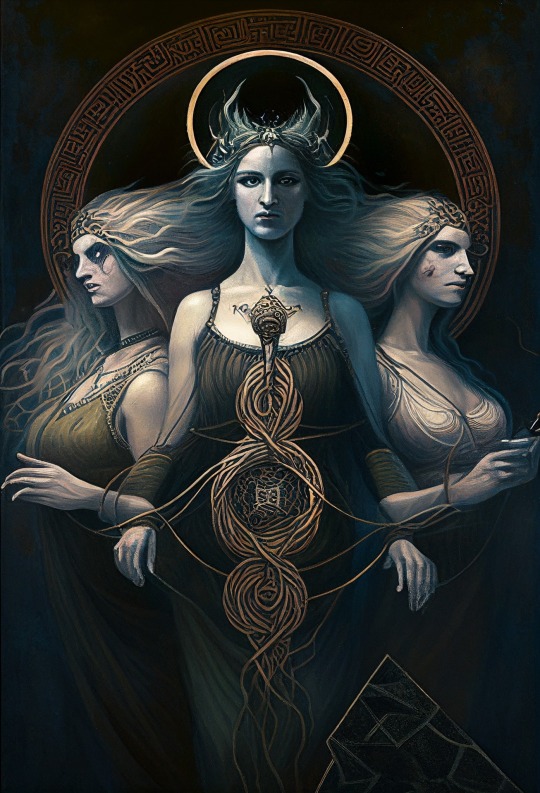
“Moirai”
The Destiny Goddesses
Talon Abraxas
Moirai: The Symbolism of Balance in a Mythological Triad
Origins of the Moirai
The three Fates, Clotho, Lachesis, and Atropos share tasks between them to keep the peace and stability of the universe in Greek mythology.
Clotho
Clotho, depicted as the youngest of the triad, was responsible for weaving the thread of life. Hesiod describes her as the youngest of the triad. The goddess’ epithet was the Spinner and has been used to describe her for centuries. The epithet might have been used by Ancient Greeks themselves as a way to describe her role in controlling the threads of life or might have been introduced later by poets and scholars who sought to further clarify her role in mythology. Some works of art and literature depict Clotho using a spindle to weave the indestructible thread that determined the life and destiny of mankind.
In Pindar’s “Pythian Ode 9”, Clotho is a “child of night” who “spins the thread of life”, therefore highlighting her connection to the larger forces of the universe. Clotho was an agent of cosmic order; with her task of weaving the thread being essential to keeping the balance of the universe.
Clotho is not only known for her powers as one of The Fates, but also as a wise and just being. In the Orphic Hymns, she is described as “you who knows all things and arranges all things in order” (l. 38). She was also associated with the concept of time as the thread they spun represented the duration of a life. The thread of life that Clotho spun represented the concept of time in Greek mythology. The length of the thread represented the length of a person’s life, which was predetermined by the Moirai. In this way, Clotho’s role as the spinner of the thread of life was intricately tied to the concept of time and the duration of an individual’s life (Graves, 1992).
Her actions are tied to her two other sisters in the triad, as after spinning the thread, it was then handed to Lachesis and then Atropos.
Lachesis
Relief figure of moira Lachesis, Puteal de la Moncloa (M.A.N. Madrid), Luis García (Zaqarbal), May 2006, Wikimedia Commons
Lachesis was responsible for the second step in the process of weaving and threading a life. Hesiod describes Lachesis as being in the middle of the triad and as middle-aged. She was responsible for measuring the length of the thread of life, defining the quotas of happiness and misfortune. Her epithet was the Apportioner, which by the Free Dictionary, means to distribute or allocate proportionally; divide or assign. This is not to be confused with a portion, which means any part of any whole; segment, or section.
While Hesiod does not explicitly state Lachesis’ role as the apportioner, he does mention that the Fates “give to men at birth evil and good to have” (l. 904), therefore implying that they have some role in distributing fate.
Furthermore, some scholars have interpreted the term “Lachesis” itself as indicating an apportioning of some sort. The word “Lachesis” comes from the Greek verb “lachan” which means “to obtain by lot,” therefore leading some to speculate that Lachesis was responsible for assigning fates to individuals by drawing lots.
Lachesis is also depicted as a just and wise figure by Plato, who describes her as “one who orders the destiny of all things in their due measure” (Pl., Rep., Book x, 617a).
Atropos
Bas relief of Atropos cutting the thread of life, Tom Oates, Creative Commons Attribution-Share Alike 3.0, Wikimedia Commons
Atropos was the last member of the triad and was responsible for cutting the thread of life. In Hesiod’s Theogony, the goddess was depicted as the oldest and most feared and was described as “the one who, with other abandoned shears, ends the thread of life”(Hes., Theog., ll.907-908).
Atropos was often associated with death and endings and therefore had been mentioned with other gods relating to death like Thanatos and Hades in Homer’s Iliad (Homer, Book xvi, ll. 849-850), and also with the goddesses Nemesis and Eris(Talbert,2004, pg. 63-64), simply for the reason that they are all associated with death and/or finality. In Homer’s “Hymn to Aphrodite“, she is described as “she who puts an end to all things and is the most hateful to mortals” (Homer, ll. 56-57). which tells us that she carries out her duties with finality. According to some versions of the myth, Atropos is said to be the one that determines when one dies, while in others, she would only carry out the tasks assigned to her by her sisters. She is also the only one out of the triad who had an actual tool – her shears- unlike the other sisters whose tools were conjured from their epithets.
35 notes
·
View notes
Note
Het were achilles and patroclus cousins? It's never been said in the illad yet people say that patroclus's grandma is achilles's great grandma , even though the illad never says this??
Maybe.
Here's Achilles' family tree per my Caroline Alexander translation:

I don't have a digital copy of Emily Wilson's translation, but it is relatively similar.
As you can see, Patroclus is not in the family tree.
Homer does mention Patroclus' father, Menoetius, a few times. He also mentions that Menoetius is the son of Aktor (or Actor). No mention of a mother.
Pindar suggest's Menoetius' mother being Aegina. Sound familiar? It should because Aegina had Aeacus who had Peleus.
Weird, right? Wouldn't that make Patroclus a peer of Peleus. Of course Aegina is a nymph and and nymphs are immortal, so a generation could have passed between her having her two sons.
I remain skeptical. I think if Patroclus had such a famous mother she would probably be mentioned by Homer as Thetis was mentioned. BUT THEN AGAIN these people were SUPER sexist so 🤷♀️
Here's the infamous Google family tree to explain the possible relation:
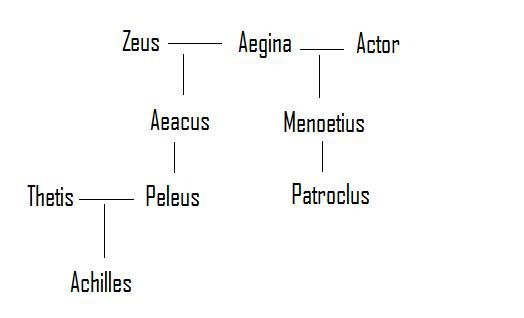
Here's a better one.
What is that like first cousins once removed?
So given it's not explicit in Homer and the connection and understanding of other sources is dodgy at best, it's really a matter of how /you/ want to define what is canon.
Is your canon The Iliad? Is it the entire Epic Cycle which we only have parts of? Or is your canon all works of Ancient Greece?
I mentioned this in another post, Greek mythology is fucking frustrating for this very reason. We know of a bunch of ancient authors who wrote about mythology and they each had their own headcanons. And of course no two headcanons are the same, just to fuck with us some more I swear.
For emphasis, here's a summary of the different hcs for Patroclus' mother:
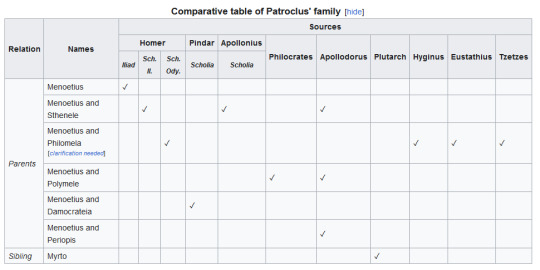
But back to the cousin thing...
At least in various civilizations in Europe, marrying your first cousin was a thing up through the mid-20th century. Just Google search any European royal family. We mainly only now find it "weird" or "creepy" bcs of our modern understanding of genetics.
Google is telling me it was common in some periods and some areas of Ancient Greece. So if they were cousins, it most likely would not have been considered "icky" by their contemporaries through Homer. I mean those ppl in Athens created ritualized pedophilia so I think cousin incest is pretty tame in comparison
Many of the headcanons floating out there by all these dead famous white men are contradictory. For example: there are multiple versions of how Achilles gained his powers, there are multiple versions of Achilles' death. It can't all be true! So pick what you like and move on. Or better yet, make up your own canon for yourself! Don't stress about it.
#don't ever let the armchair historians of tumblr make you feel bad for your hcs#fight them instead#ask#patroclus#patrochilles#achilles#it is fun to research these things and chat about it but it's nothing to get worked up over#oh and not to be /that/ person but yes the Troy movie is valid#it's a shitty white cishet hc but they have the right to make up hcs too#and yes we have a right to make fun of them#gosh i love chatting about patrochilles hcs and conspiracy theories
30 notes
·
View notes
Note
Can you make a post about the evolution of Greek art from the ancient times until now in modern age?
Because we often talk about the evolution of art but unfortunately we don't appreciate after ancient times the other art movements Greece went through the centuries.
That’s true! I am sorry for taking ages to answer this but I don't know how it could take me less anyway hahaha I made this post with summaries about all artistic eras in Greek history. I have most of it under a cut because with the addition of pictures it got super long, but if you are interested in the history of art I recommend giving it a try! I took advantage of all 30 pictures that can be possibly attached in a tumblr post and I tried to cover as many eras and art styles as possible, nearly dying in the process ngl XD I dedicated a few more pictures in modern art, a) because that was the ask and b) because there is more diversity in the styles that are used and the works that are available to us in great condition in modern times.
History of Greek Art
Greek Neolithic Art (c. 7000 - 3200 BC)
Obviously, with this term we don’t mean there were people identifying as Greeks in Neolithic times, but it defines the Neolithic art corresponding to the Greek territory. Art in this era is mostly functional, there are progressively more and more defined designs on clay pots, tools and other utility items. Clay and obsidian are the most used materials.
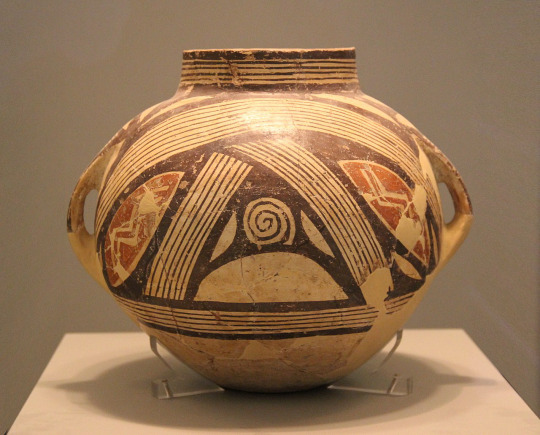
Clay vase with polychrome decoration, Dimini, Magnesia, Late or Final Neolithic (5300-3300 BC).
Cycladic Art (3300 - 1100 BC)
The art of the Cycladic civilisation of the Aegean Islands is characterized by the use of local marble for the creation of sculptures, idols and figurines which were often associated to womanhood and female deities. Cycladic art has a unique way of incidentally feeling very relevant, as it resembles modern minimalism.

Early Cycladic II (Keros-Syros culture, 2800–2300 BC)
Minoan Art (3000-1100 BC)
The advanced Minoan civilisation of Crete island was projecting its confidence and its vibrancy through its various arts. Minoan art was influenced by the earlier Egyptian and Near East cultures nearby and at its peak it overshadowed the rest of the contemporary cultures and their artistic movements in Greece. Colourful, with numerous scenes of everyday life and island life next to the sea, it was telling of the society’s prosperity.

The Bull-leaping fresco from Knossos, 1450 BC.
Mycenaean Art (c. 1750 - 1050 BC)
Mycenaean Art was very influenced by Minoan Art. Mycenaean art diverged and distinguished itself more in warcraft, metalwork, pottery and the use of gold. Even when similar, you can tell them apart from their themes, as Mycenaean art was significantly more war-centric.
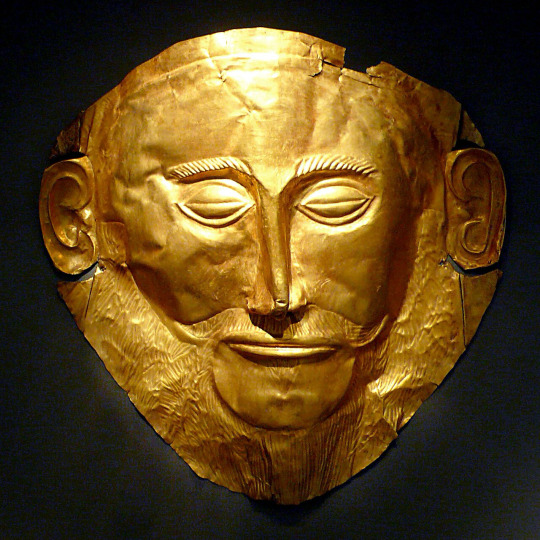
The Mask of Agamemnon in the National Archaeological Museum of Athens. The mask likely was crafted around 1550 BC so it predates the time Agamemnon perhaps lived.
Geometric Art (1100 - 700 BC)
Corresponding to a period we have comparatively too little data about, the Geometric Period or the Homeric Age or the Greek Dark Ages, geometric art was characterized by the extensive use of geometric motifs in ceramics and vessels. During the late period, the art becomes narrative and starts featuring humans, animals and scenes meant to be interpreted by the viewer.

Detail from Geometric Krater from Dipylon Cemetery, Athens c. 750 BC Height 4 feet (Metropolitan Museum, New York)
Archaic Art (c. 800 - 480 BC)
The art of the archaic period became more naturalistic and representational. With eastern influences, it diverged from the geometric patterns and started developing more the black-figure technique and later the red-figure technique. This is also the earliest era of monumental sculpture.
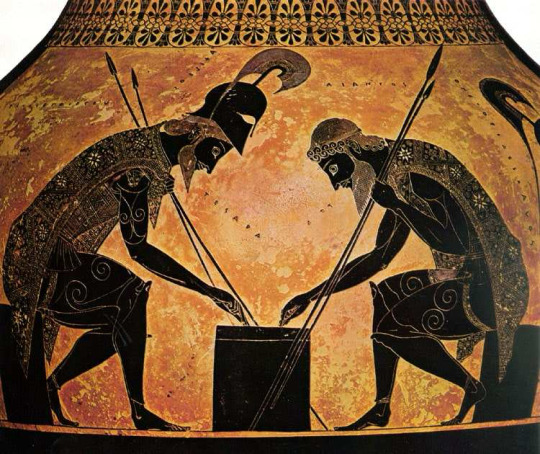
Achilles and Ajax Playing a Board Game by Exekias, black-figure, ca. 540 B.C.
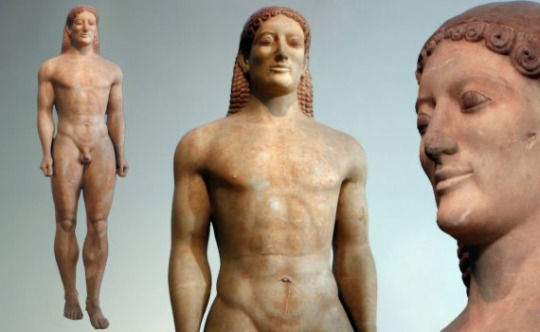
Kroisos Kouros, c. 530 B.C.
Classical Art (c. 480 - 323 BC)
Art in this era obtained a vitality and a sense of harmony. There is tremendous progress in portraying the human body. Red-figure technique definitively overshadows the use of the black-figure technique. Sculptures are notable for their naturalistic design and their grandeur.
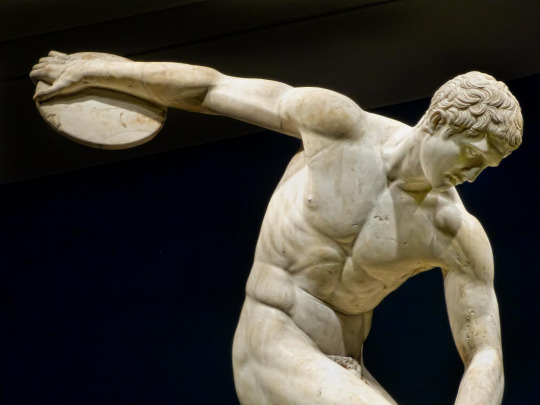
The Diskobolos or Discus Thrower, Roman copy of a 450-440 BCE Greek bronze by Myron recovered from Emperor Hadrian’s Villa in Tivoli, Italy. (British Museum, London). Photo by Mary Harrsch.

Terracotta bell-krater, Orpheus among the Thracians, ca. 440 BCE, The Metropolitan Museum of Art.
Hellenistic Art (323 - 30 BCE)
Hellenistic art perfects classical art and adds more diversity and nuance to it, something that can be explained by the rapid geographical expansion of Greek influence through Alexander’s conquests. Sculpture, painting and architecture thrived whereas there is a decrease in vase painting. The Corinthian style starts getting popular. Sculpture becomes even more naturalistic and expresses emotion, suffering, old age and various other states of the human condition. Statues become more complex and extravagant. Everyday people start getting portrayed in art and sculpture without extreme beauty standards imposed. We know there was a huge rise in wall painting, landscape art, panel painting and mosaics.

Mosaic from Thmuis, Egypt, created by the Ancient Greek artist Sophilos (signature) in about 200 BC, now in the Greco-Roman Museum in Alexandria, Egypt. The woman depicted in the mosaic is the Ptolemaic Queen Berenike II (who ruled jointly with her husband Ptolemy III) as the personification of Alexandria.

Agesander, Athenodore and Polydore: Laocoön and His Sons, 1st century BC
Greco-Roman Art (30 BC - 330 AD)
This period is characterized by the almost entire and mutually influential merging of Greek and Roman artistic expression, in light of the Roman conquest of the Hellenistic world. For this era, it is hard to find sources exclusively for Greek art, as often even art crafted by Greeks of the Roman Empire is described as Roman. In general, Greco-Roman art reinforces the new elements of Hellenistic art, however towards the end of the era, with the rise of early Christianity in the Eastern aka the Greek-influenced part of the empire, there are some gradual shifts in the art style towards modesty and spirituality that will in time lead to the Byzantine art. During this era mosaics become more loved than ever.
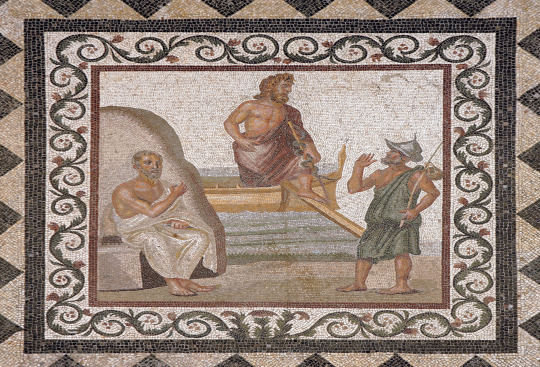
A mosaic from the island of Kos (the birthplace of Hippocrates) depicting Hippocrates (seated) and a fisherman greeting the god Asklepios (center) as he either arrives or disembarks from the island. Second or third century CE.
Introduction to Byzantine Art
Byzantine art originated and evolved from the now Christian Greek culture of the Eastern Roman Empire. Although the art produced in the Byzantine Empire was marked by periodic revivals of a classical aesthetic, it was above all marked by the development of a new aesthetic defined by its salient "abstract", or anti-naturalistic character. If classical art was marked by the attempt to create representations that mimicked reality as closely as possible, Byzantine art seems to have abandoned this attempt in favor of a more symbolic approach. The subject matter of monumental Byzantine art was primarily religious and imperial: the two themes are often combined.
Early Byzantine Art (330 - 842 AD)
The establishment of the Christian religion results in a new artistic movement, centered around the faith. However, ancient statuary remains appreciated. Most fundamental changes happen in monumental architecture, the illustration of manuscripts, ivory carving and silverwork. Exceptional mosaics become integral in artistic expression. The last 100 years of this period are defined by the Iconoclasm, which temporarily restricts entirely the previously thriving figural religious art.

Mosaics in the Rotunda of Thessaloniki, 4th - 6th century AD.
Macedonian Art & Komnenian Age (843 - 1204 AD)
These artistic periods correspond to the middle Byzantine period. After the end of the Iconoclasm, there is a revival in the arts. The art of this period is frequently called Macedonian art, because it occurred during the Macedonian imperial dynasty which generally brought a lot of prosperity in the empire. There was a revival of interest in the depiction of subjects from classical Greek mythology and in the use of Hellenistic styles to depict religious subjects. The Macedonian period also saw a revival of the late antique technique of ivory carving. The following Komnenian dynasty were great patrons of the arts, and with their support Byzantine artists continued to move in the direction of greater humanism and emotion. Ivory sculpture and other expensive mediums of art gradually gave way to frescoes and icons, which for the first time gained widespread popularity across the Empire. Apart from painted icons, there were other varieties - notably the mosaic and ceramic ones.
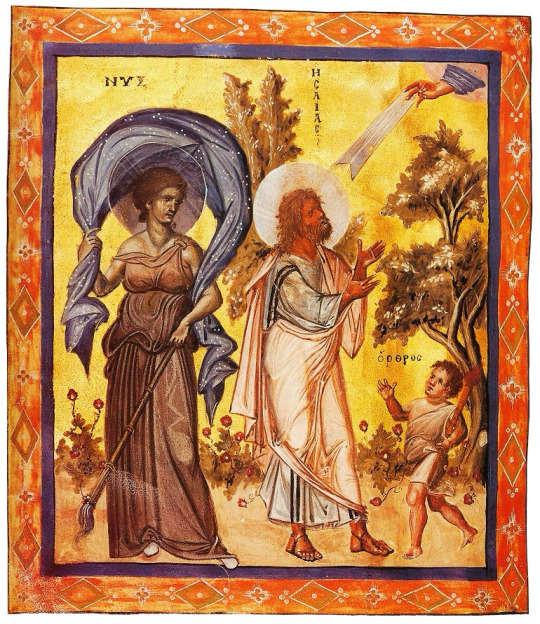
Paris Psalter, 10th century AD. Prophet Isaiah from the Old Testament in the company of the symbolisms for night (clear inspiration drawn from the ancient deity Nyx) and morning (Orthros, not to be confused with the mythological creature).
Palaeologan Renaissance (1261 - 1453)
The Palaeologan Renaissance is the final period in the development of Byzantine art. Coinciding with the reign of the Palaeologi, the last dynasty to rule the Byzantine Empire (1261–1453), it was an attempt to restore Byzantine self-confidence and cultural prestige after the empire had endured a long period of foreign occupation. The legacy of this era is observable both in Greek culture after the empire's fall and in the Italian Renaissance. Contemporary trends in church painting favored intricate narrative cycles, both in fresco and in sequences of icons. The word "icon" became increasingly associated with wooden panel painting, which became more frequent and diverse than fresco and mosaics. Small icons were also made in quantity, most often as private devotional objects.
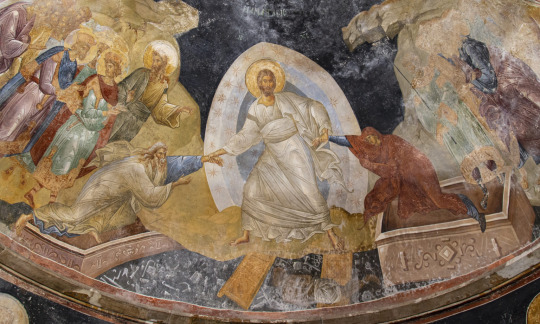
Detail of Anástasis (Resurrection) fresco, c. 1316–1321, Chora church, Constantinople (Istanbul) (photo: byzantologist).
Cretan School (15th - 17th century)
Cretan School describes an important school of icon painting, under the umbrella of post-Byzantine art, which flourished while Crete was under Venetian rule during the Late Middle Ages, reaching its climax after the Fall of Constantinople, becoming the central force in Greek painting during the 15th, 16th and 17th centuries. By the late 15th century, Cretan artists had established a distinct icon-painting style, distinguished by "the precise outlines, the modelling of the flesh with dark brown underpaint, the bright colours in the garments, the geometrical treatment of the drapery and, finally, the balanced articulation of the composition". Contemporary documents refer to two styles in painting: the maniera greca (in line with the Byzantine idiom) and the maniera latina (in accordance with Western techniques), which artists knew and utilized according to the circumstances. Sometimes both styles could be found in the same icon. The most famous product of the school was the painter Domenikos Theotokopoulos, internationally known as El Greco, whose art evolved and diverged significantly in his later years when he moved in Spain and was involved in the Spanish Renaissance, and though it often alienated his western contemporary artists, nowadays it is viewed as an incidental early birth of Impressionism in the mid of the Renaissance’s peak.

Icon by Andreas Pavias (1440-1510), Cretan School, from Candia (Venetian Kingdom of Crete). The Latin inscription suggests the icon was meant for commercial purposes in Western Europe. National Museum, Athens. (Source: https://russianicons.wordpress.com/tag/cretan-school/)

Crucifixion (detail), El Greco (Doménikos Theotokópoulos), ca. 1604 - 1614.
Heptanesian School (17th - 19th century)
The Heptanesian school succeeded the Cretan School as the leading school of Greek post-Byzantine painting after Crete fell to the Ottomans in 1669. Like the Cretan school, it combined Byzantine traditions with an increasing Western European artistic influence and also saw the first significant depiction of secular subjects. The center of Greek art migrated urgently to the Heptanese (Ionian) islands but countless Greek artists were influenced by the school including the ones living throughout the Greek communities in the Ottoman Empire and elsewhere in the world. Greek art was no longer limited to the traditional maniera greca dominant in the Cretan School. Furthermore, the Heptanesian school was the basis for the emergence of new artistic movements such as the Greek Rocco and Greek Neoclassicism. The movement featured a mixture of brilliant artists.

Archangel Michael, Panagiotis Doxaras, 18th century.
Greek Romanticism (19th century)
Modern Greek art, after the establishment of the Greek Kingdom, began to be developed around the time of Romanticism. Greek artists absorbed many elements from their European colleagues, resulting in the culmination of the distinctive style of Greek Romantic art, inspired by revolutionary ideals as well as the country's geography and history.

Vryzakis Theodoros, The Exodus from Missolonghi, 1853. National Gallery, Athens.
The Munich School (19th century Academic Realism)
After centuries of Ottoman rule, few opportunities for an education in the arts existed in the newly independent Greece, so studying abroad was imperative for artists. The most important artistic movement of Greek art in the 19th century was academic realism, often called in Greece "the Munich School" because of the strong influence from the Royal Academy of Fine Arts of Munich where many Greek artists trained. In academic realism the imperative is the ethography, the representation of urban and/or rural life with a special attention in the depiction of architectural elements, the traditional cloth and the various objects. Munich School painters were specialized on portraiture, landscape painting and still life. The Munich school is characterized by a naturalistic style and dark chiaroscuro. Meanwhile, at the time we observe the emergence of Greek neoclassicism and naturalism in sculpture.

Nikolaos Gyzis, Learning by heart, 1883.
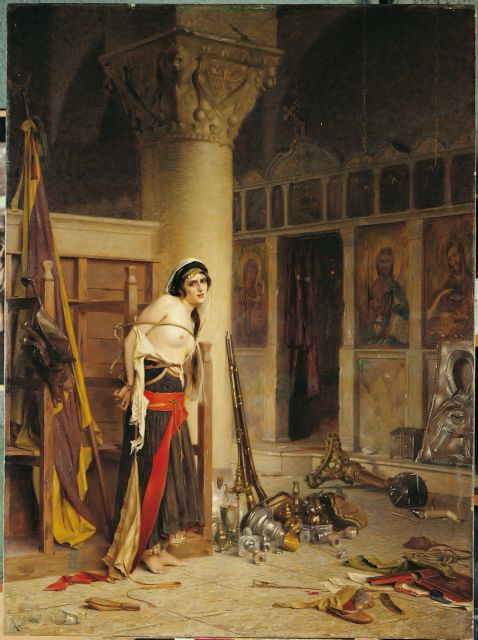
Rallis Theodoros, The Booty, before 1906.
20th Century Modern & Contemporary Greek Art
At the beginning of the 20th century the interest of painters turned toward the study of light and color. Gradually the impressionists and other modern schools increased their influence. The interest of Greek painters, artists changes from historical representations to Greek landscapes with an emphasis on light and colours so abundant in Greece. Representatives of this artistic change introduce historical, religious and mythological elements that allow the classification of Greek painting into modern art. The era of the 1930s was a landmark for the Greek painters. The second half of the 20th century has seen a range of acclaimed Greek artists too serving the movements of surrealism, metaphysical art, kinetic art, Arte Povera, abstract excessionism and kinetic sculpture.
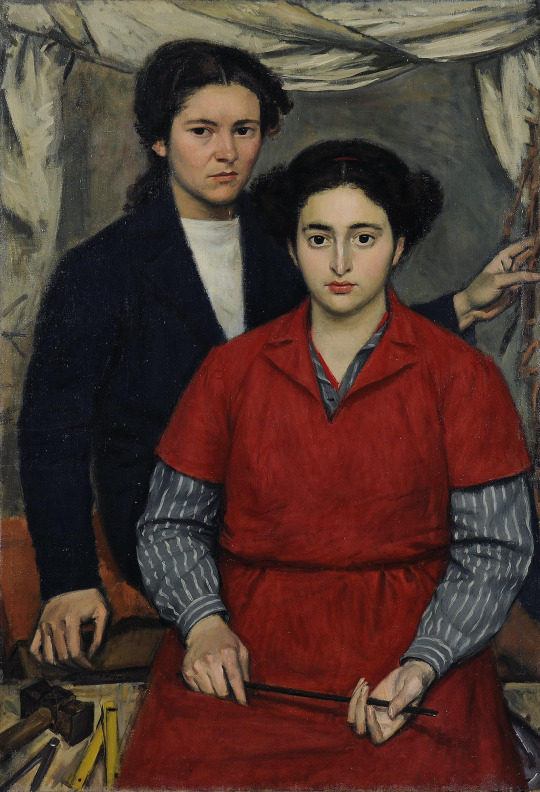
Yiannis Moralis, Two friends, 1946.
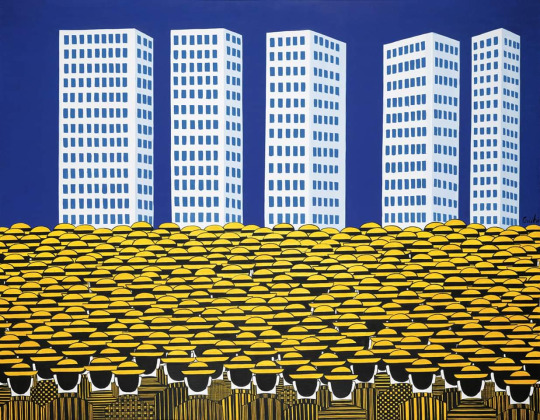
Art by Giannis Gaitis (1923-1984), famous for his uniformed little men.

By Yorghos Stathopoulos (1944 - )
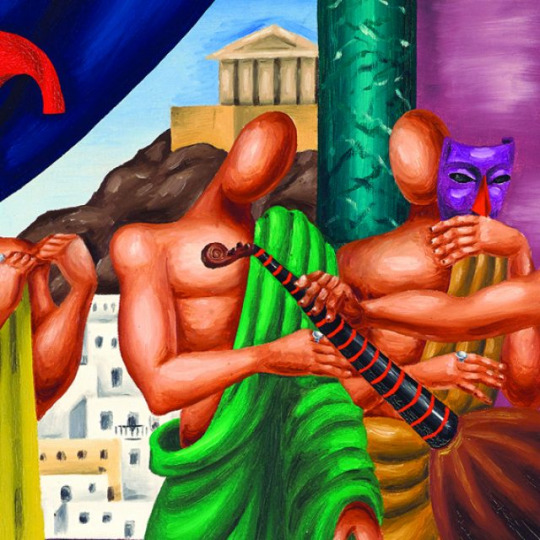
Art (detail) by Nikos Engonopoulos (1907 - 1985)
Folk, Modern Ecclesiastical and Secular Post-Byzantine Art
Ecclesiastical art, church architecture, holy painting and hymnology follow the order of Greek Byzantine tradition intact. Byzantine influence also remained pivotal in folk and secular art and it currently seems to enjoy a rise in national and international interest about it.

A modern depiction of the legendary hero Digenes Akritas depicted in the style of a Byzantine icon by Greek artist Dimitrios Skourtelis. Credit: Dimitrios Skourtelis / Reddit

Erotokritos and Aretousa by folk artist Theophilos (1870-1934)

Example of Modern Greek Orthodox murals, Church of St. Nicholas.

Ancient Greek philosophers depicted in iconographic fashion in one of Meteora’s monasteries. Each is holding a quote from his work that seems to foreshadow Christ. Shown from left to right are: Homer, Thucydides, Aristotle, Plato and Plutarch. This is not as weird as it may initially seem: it was a recurrent belief throughout the history of Christian Greek Orthodoxy that the great philosophers of the world heralded Jesus' birth in their writings - it was part of the eras of biggest reconciliation between Greek Byzantinism and Classicism.

Prophet Elijah icon with Chariot of Fire, Handmade Greek Orthodox icon, unknown iconographer. Source
If you see this, thanks very much for reading this post. Hope you enjoyed!
#greece#art#europe#history#culture#greek art#artists#greek culture#history of art#classical art#ancient greek art#byzantine greek art#christian art#orthodox art#modern art#modern greek art#anon#ask
57 notes
·
View notes
Text
"The literature of the Hellenistic period began to place more emphasis on male sexuality. For instance, in Apollonios's Argonautika, the third-century BCE reinvention of the epic that narrated the journey of Jason and the Argonauts for the Golden Fleece, Jason is not only handsome, a common characteristic of heroes since the Homeric epics, but also sexually alluring. Charles Beye has argued that this is the defining aspect of his character. Jason's sexual allure attracts women, particularly Medea, whom Jason recruits to his cause and convinces to betray her family. It can be argued that it is the magic and cleverness of Medea, rather than the heroism of Jason (who is not portrayed by Apollonios as the smartest of men), that allows the Argonauts to succeed and propels the action of the story. Jason's contribution to the success of the endeavor is therefore his ability to make women, Medea particularly, fall in love with him and follow him despite the consequences. This makes Jason a distinctly Hellenistic hero, since in contrast to traditional epic heroes, like Achilles and Odysseus (who were certainly also attractive and who had numerous sexual relationships), Jason's dominant characteristic is his power of sexual attraction. As Beye states, "His sexuality is simply the essence of his being." The literary example of Jason demonstrates that men were now viewed not only as sexual aggressors but also as objects of sexual desire for both women and other men."
Herring, A., Sexy Beast: The Barberini Faun as an Object of Desire, in: Journal of the History of Sexuality 25/1 (2016), 59.
#beablabbers#tagamemnon#art history#classical academia#ancient greece#if you can access it blease go read this article. i will also happily provide access. it's a really good read
149 notes
·
View notes
Text
Song of Achilles did make me cry and there are some beautiful, extremely quotable turns of prose. But honestly? Even without being a classicist or a Greek mythology enthusiast— it really kind of sucks. There's no substance or complexity to it, the characters are one-dimensional and it's painfully YA. It's written for a Booktok audience who doesn't give a fuck about Homer's poems or Greek myths as a genre. I mean I'm also largely disinterested but I hate books that loses everything that defines a genre in order to appeal to people who don't care for it.
Idk if you want an incredible reimagining of the Trojan war for an audience who doesn't care much about the Illiad, read The Troy Trilogy by David Gemmell. It makes no pretence of being faithful to the Illiad and takes out all mention of gods and magic, and sadly doesn't have a lot of gay in it, despite the protagonist being one of the most badass bisexual women in fantasy fiction (Andromache in the Old Guard can't hold a candle to this Andromache). But for all that, it has very complex and vivid characters, cinematic battle scenes and is an emotional rollercoaster that makes you blow through all three books in one sitting. It's very much about how war and pride and honour can make people you like and believe in do horrific things, how morality is informed by culture and era, how you can feel pity for even the worst characters, and how desolation lives hand in glove with glory. Once you read that you'll realise how hollow Madeline Miller's work is.
#incidentally also read Parmenion and The Dark Prince for a very fun fantasy romp around Alexander the Great#david gemmell is criminally underrated#he writes women like they're human beings#and his books aren't full of grimdark bloat like GRRM's#anti madeline miller#the illiad#queer fiction#book recs#david gemmell#the lord of the silver bow#shield of thunder#fall of kings#trojan war#knee of huss
56 notes
·
View notes
Text
Hello there, it’s me Momo🩷
Here’s a little description of things I love and envy
I’m from the Indian subcontinent.
Spent my entire childhood between mountains and valleys. For a change shifted to Delhi which I regret tremendously.
I love farming, gardening, stitching clothes, crocheting, writing poems and maintaining a journal.
I enjoy long walks and bicycle rides.
I prefer going to a bookstore or a restaurant all by myself. I love self-dates.
I want to settle someday at an unknown meadow with mountains and lakes at a cottage core house, with big windows and minimalistic furniture with a wooden chimney, a library with some cats and the man I love.
I’m a student, fortunately academically gifted/blessed.
I did my undergrad from Indraprastha college for women under the university of Delhi in the discipline of geography Hons. Currently pursuing my masters from Jamia Millia Islamia.
I love movies; and my favourite genre is dystopian reality. So far I have watched 750+ movies which include almost every linguistic diversity as I strongly believe in the adherence of, “you can’t find gold unless you dig the dirt.”
I love reading books, like a lot. I can speak 5 different languages and out of them, 3 languages are engraved within my system. Starting from Greek Literature Iliad by Homer to metaphysics by aristotle; reading short stories of Rabindranath Tagore in Bengali as well as reciting Gazals of Gulzar in Hindi itself, I believe I have defined base in my own culture as well as to others. Again, when it comes to dystopian, I envy reading The Hunger Games and The Maze Runners. Do Androids dream of electric sheep? Comes under my top 5 dystopian reads; as this book was later adopted into a world class movie franchise called The Blade Runner. I lean towards Harry Potter more than The Lord of the Rings. I have read A song of ice and fire which people are so batshit crazy about and famously known as the “Game of thrones.” I didn’t watch a single episode but I know more than any fan I believe.
If you intervene and ask, then yeah you can think of me as a “nerd” hehehe because my preference and taste of things leans towards being more of geek tbh🩷🩷
I also enjoy watching animated series/anime and sit coms. I’m a sucker for The Big Bang Theory and Young Sheldon and will rewatch them for an eternity if asked. My favourite anime is Gintama but the list is peculiar and long as I have been watching anime/reading manga since I was 9 years old. My first anime was Dragon Ball z and Pokémon. I also watched Doraemon and Shinchan series/movies. The list goes on when it comes to entertainment but mine is more restricted than common which people watch out of peer pressure. Below are some examples for understanding my taste and likings.
My favourite dystopian movies are (Top 20)
1. Shutter Island.
2. Interstellar
3. The Dark knight
4. The Dark knight Rises
5. Captain America: the winter soldier
6. Rouge one: a star war’s story
7. Tron legacy
8. Harry Potter and the prisoner of Azkaban
9. The Hobbit: the desolation of Smaug
10. Star Trek Enterprise
11. Star Wars: the empire strikes back
12. Blade runner
13. Blade runner 2049
14. Dune
15. V for vendetta
16. Maze runner
17. The Hunger Games
18. Oblivion
19. The Truman show
20. Eternal sunshine of the spotless mind
Top 15 Anime
1. Gintama
2. Neon Genesis Evangelion
3. Berserk
4. Mob psycho
5. Steins Gate
6. Violet evergarden
7. Monster
8. Parasyte
9. Heavenly delusion
10. Ergo proxy
11. Full Metal Alchemist
12, That time when I got reincarnated as a slime
13. Campfire cooking in another world with my absurd cooking skills
14. Barakamon
15. Bunny Drop
Top 10 Anime Movies
1. Princess Mononoke by Studio Ghibli
2. Up from the poppy hill by Studio Ghibli
3. My neighbor Totoro by Studio Ghibli
4. The End of Evangelion by Hideaki Anno
5. Spirited Away by Studio Ghibli
6. Perfect blue by Satosi Kon
7. Akira by Katsuhiro Otomo
8. Ghost in the Shell by Mamoru Oshii
9. Violet evergarden: the movie by Taichi Ishidate
10. Doraemon: Nobita’s new dinosaur by Kazuaki Imai, Toshihisa Yokoshima, in collaboration with Kyoto animation studio Wasabi Mizuta, Megumi Ohara, Shihoko Hagino.
I know it may seem boring and I usually don’t find people with such diversity, but it would be good to be a part of this community. I envy people who respects art and literature of every culture and not demeaning them.
Have a good day people muah 🩷
#entertainment#anime movie#movies#80s movies#80s anime#anime 80s#90s anime#anime and manga#anime#dystopia#science fiction#novels#fem reader#tumblr milestone
33 notes
·
View notes
Text
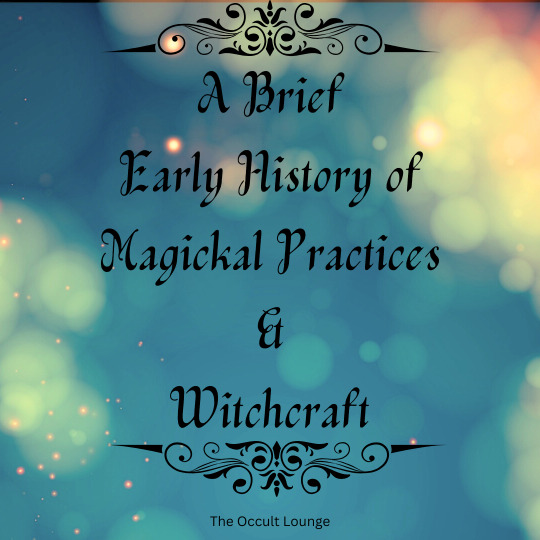
Magick is the practice of skills and abilities such as using spells, incantations, and magickal rituals. Witchcraft or Magickal Practice are broad terms that vary culturally and societally, and thus can be difficult to define with precision.
Early practitioners were people who used magick spells and called upon spirits for help or to bring about change. Most practitioners were thought to be pagans doing the Devil's work. Many, however, were simply natural healers or so-called "wise women" whose choice of profession was misunderstood.
Most people think that magickal practitioners are witches. People also believe that the idea of the witch is a Christian invention. But the idea of the witch who flies in the night and draws power from dark cosmic forces to work her ill will on another pre-dates Christianity, probably by many centuries. Most practitioners today avoid the term witch.
In Homer's Odyssey (c.800 BC), Circe - who turns men into animals - is described as a witch. Illicit magic features heavily in Roman law statutes, some of which are passed down to the Christian world. However, many of those early laws were really laws against sorcery, which, unlike 'witchcraft', can be beneficial and which requires special skills, tools, and words.
Archaeologists have found hundreds of ancient Greek curse tablets, which the Greeks called katares, 'curses that bind tight', and they appear to have invented them, with a great number focused on sporting competitions or legal contests. The inscribed tablets were left in graves, wells, or fountains, where the dead could better work their magick.
The idea of magickal practices spans a broad area of time. It can even be traced back to Mesopotamian eras where the Sumerian people, one of the earliest civilizations, would use dream magick to influence their lives. They would also use symbolic words, images, and rituals to achieve desired outcomes through supernatural means.
#discord#occultism#occultist#pagan#paganism#witch#witch community#witchblr#witchcraft#witches#occultblr#magick#occult
32 notes
·
View notes
Text
In my opinion, instead of constant clamoring for Greek mythology retellings where largely or entirely villainous or monstrous female figures are reinvented as heroic, what we need is more media which acknowledges any goddesses from outside the conventional groupings of “main” Olympians (which is something variable, the version of the dodecatheon from Olympia had the personified river Alpheios and the Charites in it , but that’s beside the point). Multiple of them actually have well defined, more or less consistent characters in myths and it’s mind-boggling that they are losing the quest for popcultural relevance with “what if Medusa was the central protagonist of Greek mythology” text posts.
Off the top of my head, some good examples of such goddesses would be:
Hecate, who despite being portrayed firmly positively in her two main mythical roles, in the Homeric Hymn Demeter (where she helps Demeter look for Persephone and is later tasked with escorting her on her annual journey) and in the Theogony (where she aids Zeus and co. during the titanomachy), only ever appears as a villain in modern media, often with the point of reference being godawful new age literature or worse. The only two works of media which actually try to do something broadly accurate to her character in myths would be Theia Mania and, of all things, Touhou.
Selene, who basically doesn’t exist as a separate character in modern media because her gimmick has been reassigned to Artemis. To be fair, it’s been this way for centuries, but she actually has a plenty to offer if treated as separate. She has a very distinct iconography (lunar crescent behind the shoulders looks so cool), and at least according to Seneca a very warm relationship with her brother (in his Phaedra he fills in for her every now and then so that she can spend time with Endymion). There’s also a bonkers addition to the Labors of Heracles where she’s credited with raising Nemean Lion from the moon.
Iris, who acts as a messenger of the gods (or specifically Hera) pretty often, including during the titanomachy. She also has a unique genealogy, and an “evil twin”, Arke, who acted as the messenger for the titans and to my knowledge plays no other role anywhere otherwise. One of the only references to offerings made to Iris mentions cheesecake which one surely could turn into a personality quirk if the actual literary texts are not enough, too.
Eos, dawn, the OTHER sister of Helios, who persistently appears in myths indicating she was the one female deity sort of trying to keep up with male gods in the “romancing mortals” department. One of her lovers turned into a cicada because she forgot to ask for eternal youth when asking for eternal life for him which feels like it came out of a modern parody.
Styx, who I think basically is entirely forgotten as a personified deity in modern fiction, despite being portrayed as one of Zeus’ key allies in the Theogony, and as the mother of his various minor courtiers. You’d think a character as edgy as the personification of the arguably most famous location in the underworld would not be entirely absent from mythology adaptations but alas, she basically is.
I would also like Thetis to not be portrayed as antagonistic in media, both of her highest profile adaptations in recent years essentially are. Thetis is the best character in the Iliad and I’d like to see an adaptation which actually keeps the scene where she brings Briareus to Olympus, but it feels like Iliad adaptations are often ashamed of having gods in there.
If you want to dig deeper, there are oddities like Malis/Maliya, a craftsmanship(?) goddess from Lydia and Lycia treated as analogous to Athena back at home, but seemingly as a river nymph in Greece (I worked on her wiki page recently).
261 notes
·
View notes
Note
Hi AV,
I am an oceanographer and here are some beautiful, sea-related words for you to play with: bioluminescent, moonglade, spindrift.
They made love in the hot fever dream of a mangrove forest in Puerto Rico, the sea awash with bioluminescent dinoflagellates beneath a waning moon.
The case wasn’t even specious; there was a proper murder and everything, NCIS out at Roosevelt Roads. Scully used to be adamant about sex on cases for reasons she couldn’t define but that eroded like initial proscription against sleeping with her partner in the first place.
She is endlessly adaptable. Mendelian, Darwinian. A survivor.
The ocean laps between her thighs like her lover, who is sprawled in the shallows like a feeding manta ray. He basks beneath the heavens, naked. Sated.
She remembers fucking him for the first time in the sea in San Diego after Emily, the Pacific cold in December and frosted with moonglade. Her brother, her mother, asleep in the holy dark.
She’d sobbed into his shoulder, she bit it until he bled, she remembered that blood is practically seawater. He thrust into her until she bled too, until even her god looked away.
Scully warm and drowsy now in the lush, glowing mangroves. “I love you,” she says to the stars.
Mulder says nothing, takes her hand in the simmering blue glow of the night water.
Inside her, a restless ocean calms. Leucothea, goddess of spindrift, brought Homer to Scheria. It was a utopia, it was paradise. She rolls on her side towards him, she planes his chest with her right hand.
By Christ and all the others, one day she’ll see him safely home.
49 notes
·
View notes
Text
"I just wanted a callsign of my own...."
In one of the early missions of Armored Core VI you take down a tester mech and it's pilot, a clueless young kid who never stood a chance against a battle-hardened mercenary like you. His last words before he's sent across the river Styx are simple and honest.
He just wanted a callsign, he wanted to be known, to have a place in the world, a reputation. It's the classic young boy who wants to be a badass like the men he idolized; he just wants to be like his heroes.
And then one of his "heroes" sends him to God without a second thought, silent like the Reaper himself.
A reminder that perhaps lionizing those whose profession is defined by Homeric violence can be a bad move.
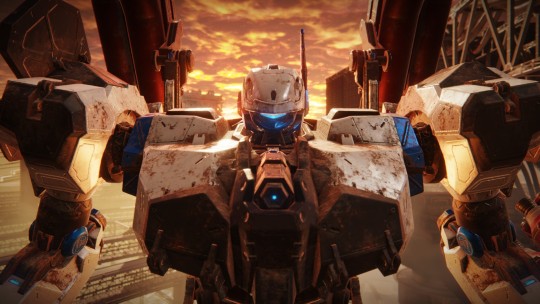
41 notes
·
View notes
Note
Do you think writers should use more of a well-defined morality approach to the widespread "grey"? Though the former has always been criticized for its simplicity and irrelevant to the real world, the franchise under George Lucas looked like a gateway for philosophical understanding.
If possible, as someone who understands it well, what is your opinion on the separation of Pure Evil (ingrained by DNA) and Broken characters?
I think that when it comes to writing, we need to distinguish between layout and morality, because only then we can address the problems with separating Pure Evil and Broken characters!
I think writers should use a more well-defined morality approach, but that's different from the conventional morality approach, I call it light-and-dark morality as opposed to black-and-white.
Layout: "black-and-white" and "grey"
BLACK-AND-WHITE LAYOUT:
In black-and-white layout, the characters are arranged along clearly and strictly defined lines: we have the heroes who are Good and we have the villains who are Evil. We have these sides opposing each other, and it's very clear which side we should identify with and who should win. The overwhelming majority of the most popular stories of our time, including but not limited to George Lucas' Star Wars, uses black-and-white layout. Jedi Knights versus Sith Lords, the Rebellion versus the Empire, the humans versus the orcs, wizards and witches versus the Death Eaters, Gandalf the White versus the Dark Lord, Snow White versus the Evil Queen, the Pevensie children versus the White Witch and so on. It's important to note that this doesn't mean that heroes can't turn into villains and villains can't turn into heroes, nor does it mean that there can't be hero figures on both sides, but but it means, that will always be a clear shift from Good to Evil and from Evil to Good, or that the heroes of the Evil side are deceived.

Black-and-white layout sometimes might allow for "grey" characters. The mildest example of this might be Grumpy in Snow White, who is quite hostile to the sweet princess, but who obviously loves her, and then there is Hondo Ohnaka in Clone Wars, who is a criminal and serving only himself, but there are signs of willingness to do good. But most often than doesn't, "grey" eventually must choose.
GREY LAYOUT
Grey layout is understood to be a relatively new type of layout for a story, but Homer's Iliad could be one of the most ancient surviving examples of it: there is a king who fights for his honor, a king who fights for his city, a prince who fights for love, a warrior who fights for glory. We can identify and empathize with both sides, or at least we can find both sides' actions comprehensible, plausible. I think the best example of grey layout today would be Netflix' Arcane, where, even though we can point out the least sympathetic characters, we can't comfortably declare one side Good or Right and the other Evil or Wrong, whereas in black-and-white layout, this is a very easy task.

Grey layout can be seen as a more realistic layout for a story, trying to address complex, contemporary issues, while the black-and-white layout is more metaphorical, focusing on conveying universal lessons and messages in an abstract way that can be translated to concrete situations. In this sense, stories with grey layout seek to present reality and bring attention to concrete issues in the real world, and stories with black-and-white layout are focusing on presenting role models, to raise human beings who are able to solve concrete issues.
Morality: "black-and-white," "black-and-broken-and-flawed-and-white," "grey" and "light-and-dark"
BLACK-AND-WHITE MORALITY
Black-and-white morality can exist only in a black-and-white layout, but it's crucial to understand, black-and-white layout doesn't always results in black-and-white morality. In fact, black-and-white morality stories are quite rare and they can end up being criticized for being overly simplified and for failing to be applicable to reality. In black-and-white morality, everything between birth and death can be seen as a war between clearly and sharply defined poles of Good and Evil. Good is always the most morally pure and satisfying, most just and also nicest thing to do, and the Good Ones are always doing Good.

The only ones who are dissatisfied with them are the Evil Ones, who are willfully and consciously fighting against the morally pure and satisfying, the just and nice, and do Evil, the exact opposite, instead. Black-and-white morality isn't trying to explain or understand Evil, it only focuses on identifying it, locating it and destroying it, which is, of course, the Good thing to do. In black-and-white morality, Evil is understood to be either as is a quality that we are born with (i.e. "ingrained by DNA") or that Evil is something like an infection that is nevertheless under our conscious control (i.e. "you sold your soul!") Lord of the Rings is the closest thing to black-and-white morality stories: the heroes are creatures of light and grace or modesty and simple good-will, they're noble and well-meaning, even though they can be corrupted by Evil, which is a creature of fire and darkness, leading an army of deformed, vile, animalistic monsters.
BLACK-AND-BROKEN-AND-FLAWED-AND-WHITE MORALITY
The reason why black-and-white morality faces with increasing criticism for is the fact that it fails to address the complexity of life: whenever we look deeply into the heart of someone we identified as Evil, we find that they actually don't meet the criteria: they, just like ourselves, simply want to be happy and not to suffer, and this is at the core of everything they do. They don't see themselves as Evil, they didn't vow to destroy Good. In fact, more often than doesn't, they're, too, victims of Evil. Black-and-white morality is sometimes replaced with another type of morality that includes Broken, who is like a white chess pawn moved by the player who is with black: they are not Evil, but, in truth, they're Good, who are the victim of Evil, and because the Evil that was done to them, they are twisted to a place where they themselves do Evil. It would be important to realize that this is still black-and-white morality: it insists on the existence of Evil that must be identified and destroyed without any hesitation or compassion and it asks us to believe and not to ask questions when it points at someone and says "Evil" and at another saying, "Broken."

The morality that separates Evil and Broken is just black-and-white morality trying to delay the inevitable collapse of the entire binary upon which it was built, and by doing so, it also paralyzes its heroes. Treating Broken characters as Evil would fail to meet with the criteria of Good, therefore, each and any character who decides to respond with countermeasures to the Evil done by Broken characters cannot be Good - they're flawed. In fact, so the reasoning goes, Good would make Good attractive enough for the Broken, so they won't choose Evil, thus ultimately, anything that the Broken character did, was the fault of the Flawed characters. True Good characters must gather all their Goodness and radiate it to Broken characters, and turning them back to Good as a result. It would be important to note that this type of morality is often presented as relevant and nuanced, but in truth, it's an even more severely absolutist morality that cannot tolerate nuance and fails to address the complexities of life, insisting on a dangerously simplistic view. However, its popularity is growing in fandoms, even though to this date, it manifested itself only in hot takes built on "death to the author!" theory.
GREY MORALITY
Grey morality can be defined in many ways, but it's essentially the rejection of black-and-white morality paired with the view that Good and Evil are both just ideas and the line between right and wrong is blurred. Although grey morality is seen by many as the morality that moves beyond the dichotomy of Good and Evil, it should be noted that it stops at rejecting this dichotomy - it's either not equipped or not willing to explore a post-black-and-white reality. For this reason, apart from dwelling on the absence of the clearly and strictly defined lines dividing Good and Evil, stories adopting grey morality are not really having much to say, it doesn't really know where to go from there, since although it pushed the old moral compass aside and didn't make a new one to navigate. Grey heroes are usually angsty, edgy, "not good so that's bad but not evil, so that's good" figures.
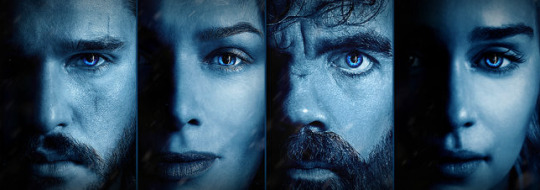
It should be noted that stories adopting grey morality can deal with complex and relevant issues and can communicate very important messages, and grey characters can develop or mature. In fact, most of them ends up doing immense good to others, so grey morality sooner and later does try to a re-establish black-and-white layout, but it presents heroes and role models who are careful not to rise the bar too high, since grey morality holds an essentially skeptical views on humanity. Although it won't come to any profound conclusion about Good and Evil and how to conduct ourselves in the world, it does try to update Good and Evil in a way that says, "It's OK. No one is perfect, just keep trying to do your best, that's all that can be asked, really." Game of Thrones or Hunger Games might be good examples of this.
LIGHT-AND-DARK MORALITY
Although light-and-dark morality can exist both in black-and-white layout and grey layout, it's the least popular type of morality, since it challenges the conventional story of Good and Evil, even though it defines "good" and "evil" very strictly and clearly. In a nutshell, light-and-dark morality tells us: anything we resent in another person is also within ourselves, a part of all that lives. Evil behavior arises as a result of other causes and conditions, the "dark" parts of ourselves: fear, anger, hate aggression, greed, selfishness, bitterness, jealousy and so on, and an Evil Person is a person who is under the sway of these parts themselves. Therefore, although light-and-dark morality acknowledges the reality of conflict, in place of the struggle between Good and Evil and the quest to identify and destroy external Evil, it emphasizes identifying and conquering our own dark side and the understanding of the true nature of Evil, as a way of really winning battles between what is understood as Good and Evil. Therefore, the struggle is to keep the roots of Evil within ourselves under check and to cultivate compassion, wisdom, generosity and mindfulness.

Light-and-dark morality, therefore, proposes, there is no Evil that we can identify and destroy and then label it a Good and Right thing to do, to which only those will object who are consciously and willfully chose to fight against the most morally pure, most satisfying and nicest thing. This is a conclusion that black-and-white morality tries to avoid by separating Evil and Broken characters, since it clings on the notions of absolute Good and absolute Evil. The light-and-dark morality tale equates Evil with Broken, and it indicates, we must be able to recognize when we have to stop fighting for the Broken and we have to start to fight for those who must be protected from the Broken, who inflicts pain and suffering and harm onto others. Thus, light-and-dark morality rejects the idea, the Good and Right thing is always satisfying and just and nice to everyone: it proposes, we must accept, in many cases, the right thing to do isn't the nicest, the most gentle or most pleasant or most agreeable thing to do; the wrong thing to do isn't always the nasty, mean, unkind, unpleasant thing to do. And unlike grey morality that blurs the lines between good and evil, light-and-dark morality proposes, everything has a dark and a light side: there is no action that is inherently good or evil, whether it becomes a good or an evil act will depend on our motivations and the circumstances we're in. George Lucas' Star Wars story is one of the best examples of light-and-dark morality: he defined the battle between Good and Evil is defined as a battle between selflessness and selfishness, that is, in truth, the battle between no-fear and fear. Jedi Knights are focusing on doing good and to prevent evil from rising, but in order to do that, they must do things that aren't Good according to the criteria established by black-and-white morality.
#morality#grey morality#black and white morality#star wars#George lucas#writing#good guys and bad guys#good and evil#anon ask#evil or broken
25 notes
·
View notes
Text
Someone in my offline life asked why I bother writing Star Wars fanfic, listing off Disney’s various and assorted sins, all of which of course I agree are awful! BUT. I think Star Wars as a concept doesn’t actually belong to the company that bought the legal right to wring as much profit out of the IP as possible. Star Wars is actually much larger than that.
Star Wars is a massive cultural project, almost half a century old, comprising all forms media, all forms of both official and folk art. It's a densely woven tapestry of stories, the fruits of the labor and inspiration of thousands and thousands of people. It's honestly the mythology of many of our childhoods, and it belongs to us in a way that capitalism can’t touch.
It's truly a global phenomenon too! Writing stories and sharing my theories about Star Wars has brought me into being a member a vast community of people, like I've had people ask to translate my stories into Russian, Italian, Chinese. I've had comments in my story written in so many languages. I have made friends across the globe, all from sitting at my isolated farm in rural USA.
That's the reason that I write Star Wars, beyond enjoying the Force, the Jedi, the infinitely expandable galaxy, etc. like there's room for everybody to tell stories. It's a beautiful, special thing that I wouldn't trade for anything. I personally LIKE joining in and adding my voice to an ongoing conversation among people who are excited about the heroes and stories that defined my childhood.
The entire idea of mythology only being available for a corporation, and not for the fans, is absurd to me. If we were in ancient Greece, and you said that you and your friends like to sit around and tell each other stories about Homeric characters, nobody would find it strange! Homer and the Homeric heroes were the pervasive stories that everybody vaguely knew and everyone had the context to easily enjoy a retelling.
I'm a prequels kid, and for me and many people in my generation, Anakin Skywalker, Padmé Amidala, and Obi-Wan Kenobi, and the fall of the galactic republic are formative stories seen at the ages when stories really matter. The generation before might have had Luke Skywalker, Princess Leia, Han Solo—these figures are so archteypal, they belong to all of our collective imagination. Disney has nothing to do with that.
#star wars#ok that ended up being a longer rant#than i meant it to be#but this is very important to me#star wars belongs to us#it is ours#it should be in the public domain#lucas has been plenty well compensated#what is happening now is just extractive cynical capitalism#and makes me livid lmao
431 notes
·
View notes